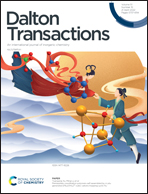Application of the anthraquinone drug rhein as an axial ligand in bifunctional Pt(iv) complexes to obtain antiproliferative agents against human glioblastoma cells†
Abstract
Octahedral Pt(IV) prodrugs are an effective way to combine cisplatin-like moieties and a second drug to obtain selective and stimuli responsive bifunctional antiproliferative compounds. Recently, two bifunctional Pt(IV) complexes have shown interesting in vitro and in vivo effects in glioblastoma, the most aggressive primary brain tumor. An interesting observation indicates that 4,5-dihydroxy-9,10-dioxo-9,10-dihydroanthracene-2-carboxylic acid (rhein) can inhibit in vivo glioma tumor progression. Furthermore, a prodrug in which cisplatin was combined with two molecules of rhein showed a potency higher than that of cisplatin toward cisplatin-resistant lung carcinoma cells. However, the high lipophilicity of this type of complex affects their solubility and bioavailability. To overcome these limits, in the present work, three Pt(IV) derivatives were obtained by differently linking one molecule of rhein and one acetato ligand at the axial position to a cisplatin core. The complexes proved to be similar to or more potent than the parent cisplatin and rhein, and the reference drug temozolomide on two human glioblastoma cell lines (U87-MG and T98G). They retained their activity under hypoxia and caused a significant reduction in the motility of both cell lines, which can be related to their ability to inhibit MMP2 and MMP9 matrix metalloproteinases. Finally, physicochemical and computational studies indicated that these Pt(IV) derivatives are more prone than rhein to cross the blood–brain barrier.



 Please wait while we load your content...
Please wait while we load your content...